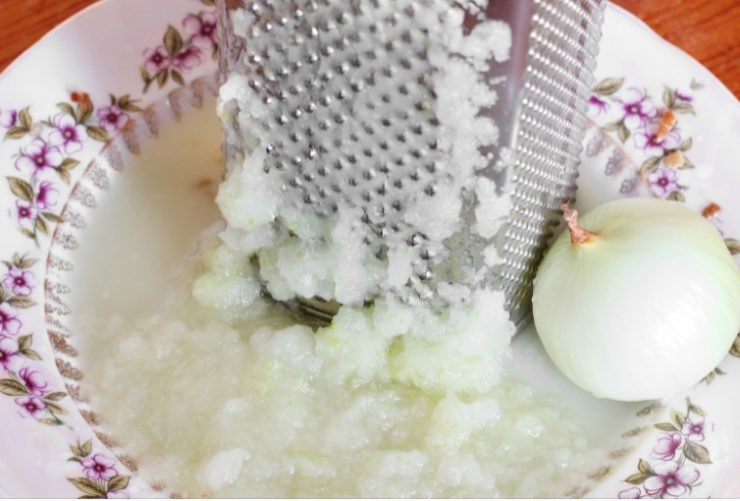Onions are one of the most commonly used ingredients across almost any cuisine. They add flavor, aroma, and are often the underlying backbone of a dish or sauce, especially when onions are grated.
If you want the flavor of an onion, but you want it to melt into a dish without adding any large, noticeable pieces, grated onion can be a great solution.
Stick around to learn how to grate an onion, what tools you’ll need, and how to avoid the pesky tears that often come with the territory.
In This Article
Choosing The Right Onion
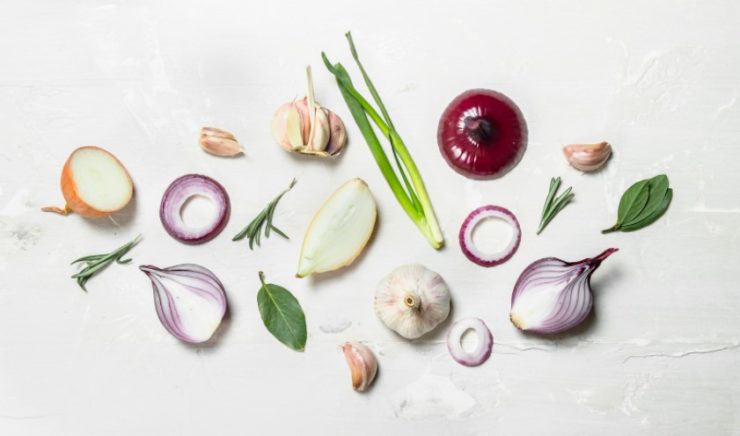
Different dishes call for different types of onions. But, if your recipe includes grated onion, chances are good that you’ll be using yellow, white, or sweet onions.
Those three types of onion, along with red onions, are also the most common variety that you’ll find in most grocery stores. So, you shouldn’t have to search very hard to find the right one.
The large, uniform size and lack of color make all three perfect candidates for the job. Of course, you could grate pearl onions or cippolinis instead, but that’s a prep task I wouldn’t wish on even my worst enemy.
When picking out your onions, look for ones that are very firm and heavy for their size. You want to avoid onions that are sprouting, or that have any give or soft spots when you press them.
Then, once you get your onions home, store them in a cool, dry, dark area, with good airflow if possible.
Avoid storing your onions in the fridge. The cold temperature causes starches in the onion to rapidly convert to sugars, which will lead to faster spoilage.
How To Grate An Onion In 3 Steps
Clean
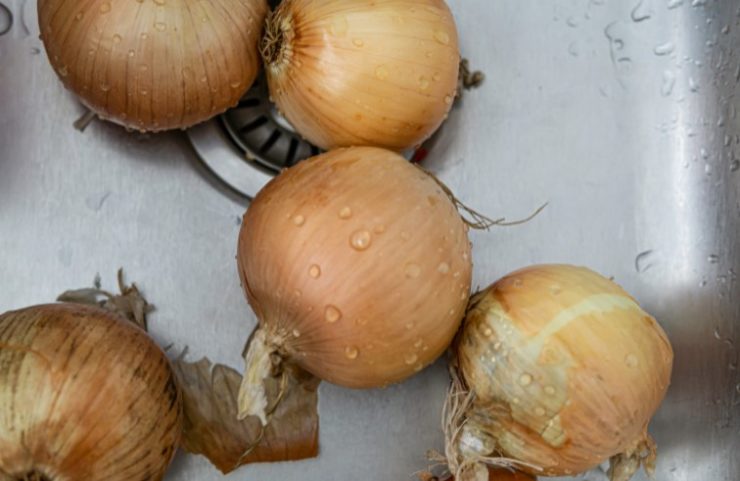
As far as pesticides are concerned, onions are often considered to be one of the “cleanest” types of produce.
But, even if there aren’t pesticides present, there could still be rogue bacteria lying unseen on the surface, or hiding in dirt particles. So, it’s still best practice to give them a rinse under running water before making any cuts.
And even though you’ll be peeling the onion, when you make your first cut, you can transmit bacteria from the surface of the peel to the inner flesh of the onion.
So, before processing, take an extra few seconds to give a thorough rinse to remove any debris.
Peel
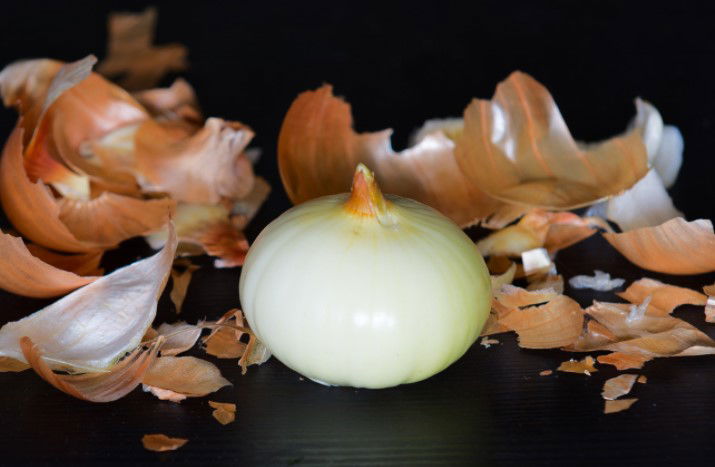
Lay your clean onion on its side on your cutting board. Hold the onion in place with your non-dominant hand and cut off the top of the onion (the end opposite of the roots).
To ensure the highest yield, try to cut through only one layer of onion when removing the top.
Next, stand the onion up on the now flat top that you just made.
Once again, hold the onion in place with your non-dominant hand. Then split the onion in half, cutting down through the root end.
You can now peel away the papery skin and any other damaged or bruised outer layers that you find. If there’s a thin layer of outer skin that you can’t get off, use the edge of your knife to get under the skin then peel it back.
Keep the root end intact to act as a handle, and also to help hold all of the onion layers together while you’re grating.
If peeling feels difficult to you, we have a more detailed guide that can help you through that part of the process.
Grate
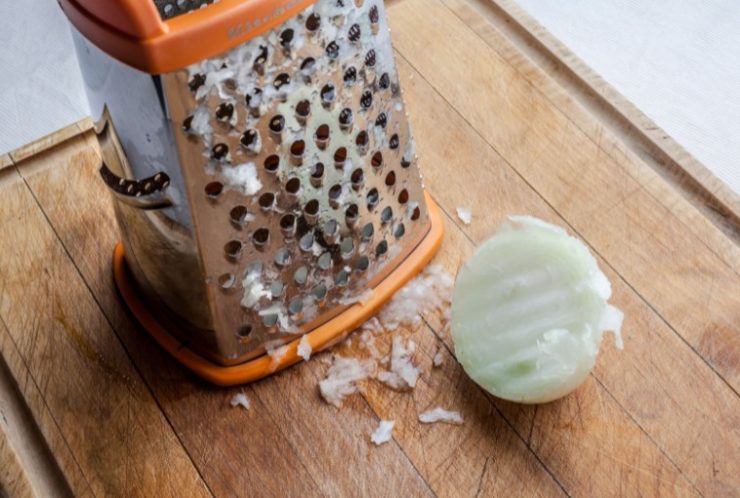
If a recipe calls for grated onion but doesn’t specify size, you can generally assume that you’ll use the largest holes on most hand-held or box graters.
So, grab your grater of choice and place it in or over a large bowl. Hold the grater with your non-dominant hand and one of your peeled onion halves in the other.
Hold the onion by the root end and pass it back and forth over the grater using moderate pressure. As you get closer to the end, use the root as a handle and adjust the angle of the onion so that you can grate everything down to the root, or basal plate.
You can also do your grating directly on your cutting board, but using a bowl minimizes the mess and ensures you don’t lose any onion juice.
Storing Grated Onions
If you won’t be using your grated onions right away, store them in an airtight container in the fridge. Inexpensive deli containers are usually my go-to when prepping produce. But, onions tend to leave plastic containers very…well, oniony even after they are washed.
So, to avoid imparting an unwanted hint of onion to the next thing I use the container for, I turn to glass containers or disposable plastic bags.
Your stored, grated onions can start to develop a more intense flavor and aroma in the fridge, so try to use them within 3 days for the best results.
What To Do With Onion Scraps
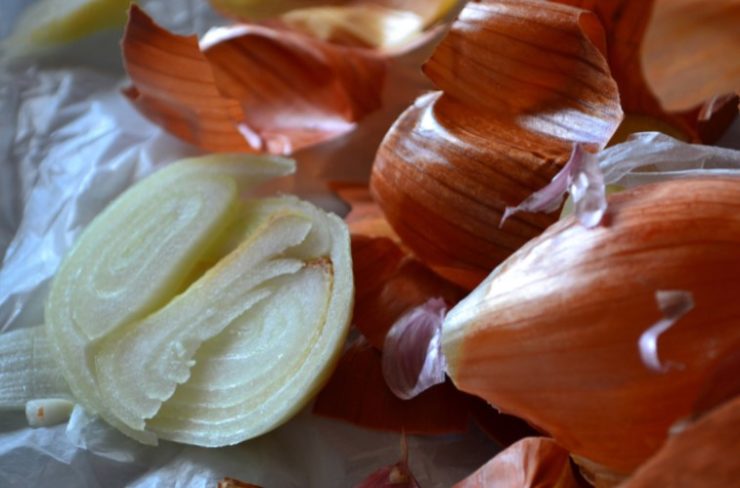
There shouldn’t be a whole lot of waste when preparing onions with a grater. But, you can save your top end, root end, and skins to be used in your next batch of stock.
And if making stock isn’t on the agenda in the immediate future, save a collection of vegetable trim in a bag in the freezer until you have enough scraps and time to make a batch.
Avoiding Tears And Injury
No matter how big and tough you are, there’s a good chance onions are going to make you cry when you’re prepping them.
As the cell walls in onions are damaged they release an enzyme called alliinase. This floats up into our eyes and causes the stinging, tear-inducing sensation that all prep cooks dread.
Usually, my advice is to use a very sharp knife for any onion prep. This causes less cell damage, so less alliinase is released. Unfortunately, most of the graters I’ve ever come across are not exactly razor-sharp.
But, we can also minimize alliinase release by lowering the temperature of the onion. I still don’t advise storing onions in the fridge for long periods of time. But, you can chill your onions in the freezer for about 30 minutes without causing them any harm, and also lowering alliinase production.
Alternatively, you can do your onion prep al fresco (outdoors), or use goggles to keep your eyes out of harm’s way.
And when it comes to keeping your fingers and knuckles safe, using onions that are cut in half, and leaving the root intact offers a better grip to minimize injury.
And to further protect your digits from such a fate, you can use a piece of paper towel or a small kitchen towel to provide even more grip on the onion while you grate.

Pro Tip: Reduce the enzyme that leads to crying by chilling your onions for about 30 minutes before you grate them.
Why Grate An Onion vs. Dice An Onion
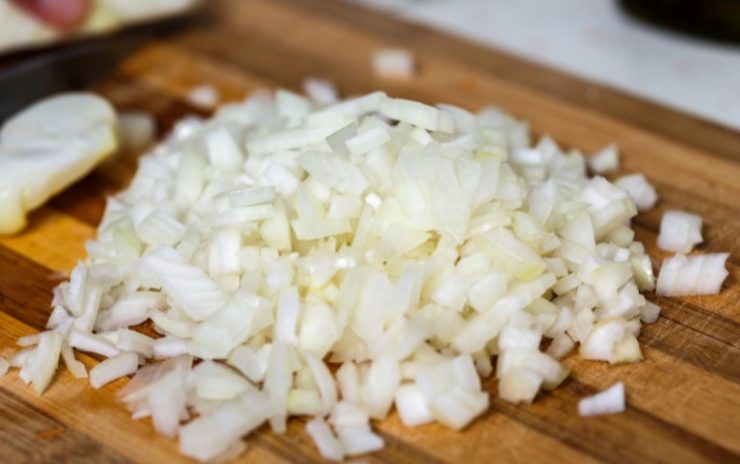
In most cases, you’ll use grated onion when you want onion flavor but no onion texture.
Grated onion can easily melt into the background of a dish, and are often used for sauces that you want to be smooth without blending. Or, in things like stuffing, meatballs, and potato pancakes.
Some may also say that grating an onion is faster and requires less skill (is that a benefit?) than dicing one. But, with a little practice, you can easily dice an onion as fast as you can grate one. I’m currently accepting challengers if anyone is interested.
How To Get Similar Results Without A Grater
It’s hard to replicate the texture of a grated onion using only a knife. You can chop and mince till the cows come home, but you still won’t get the same, sort of crushed texture.
The next best option is to pulse a roughly chopped onion in a food processor. You might still end up with more chunks than with a grater, but it should be passable.
Another option is to dice an onion and then gently pound and grind it by hand in a mortar and pestle.
Tools For The Job
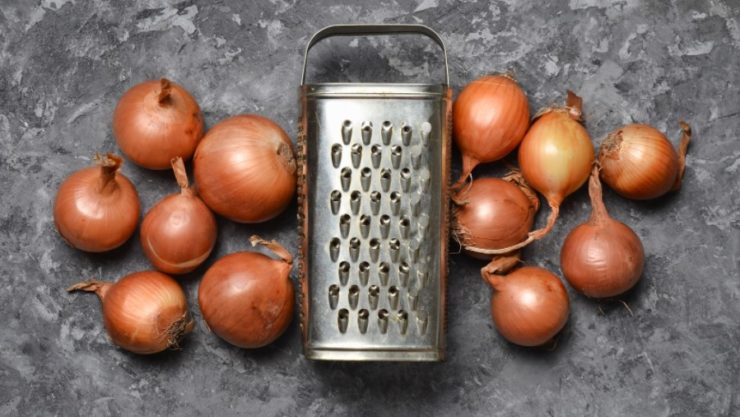
There are minimal tools required when it comes to grating an onion. The very basics are a sharp knife (preferably chef knife) and cutting board to trim and peel the onion and a handheld grater.
Optionally, grab a large bowl to do your grating into to minimize mess and cleanup.
Frequently Asked Questions
What Is The Best Way To Grate An Onion?
The best way to grate an onion is to split it in half and peel it, leaving the root end intact. Then, use the root as a makeshift handle while you shred the onion on a handheld or box grater.
Can You Use A Grater To Dice An Onion?
Technically, a grater cannot be used to dice an onion. Grating an onion creates a very different shape than dicing one. You may be able to use grated onion in place of diced ones in some recipes, but they are not the same.
Is Onion Powder A Substitute For Grated Onions?
You can use onion powder as a grated onion substitute in a pinch although the flavor will not be exactly the same. Use about 1 teaspoon of onion powder to replace a whole medium onion.
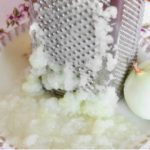
How To Grate An Onion
- Total Time: 5 minutes
- Yield: Varies
Description
Learn how to grate an onion for the classic onion-y flavor that melts into a dish without adding a lot of chunks and texture.
Ingredients
- Onions, 1 each
Instructions
- Rinse onions under running water to remove any debris.
- Use a sharp knife to trim off the very top of the onion. Leave the root end intact.
- Use the flat top to stand the onion up and cut it in half through the root end.
- Peel away the skin and any bruised or damaged outer layers.
- Hold a handheld or box grater against your cutting board or in a bowl and shred the onion one half at a time, using the root end as a handle.
- Save the onion peels and stem for stock or discard.
Notes
If you don’t have a grater, rough chop the onion and pulse it in a food processor.
- Prep Time: 5 minutes
- Category: Knife skills
- Cuisine: Any
Keywords: how to grate an onion, grated onion
